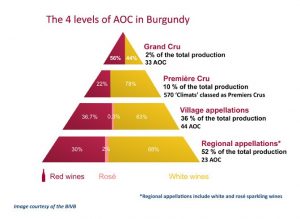Think of it as a pyramid. There are 4 main categories.
- Regional AOCs – These are called Bourgogne and can be red or white. This is generic Burgundy, and as such, it is possible to blend wines from different parts of Burgundy to make AOC Bourgogne.
- Village AOCs – Wines made entirely from grapes from a specific village.
- Premier Cru – Vineyards inside a particular village that were classified as exceptional when the AOCs were codified. Named for the village they are found in, followed by the specific vineyard name (as here: the village is Savigny-Les Beaune and the 1er Cru vineyard is ‘Les Peuillets’).
- Grand Cru – The crème de la crème. These are vineyards with historical importance, vines that were known well before the AOC regulations came to be. They do not take the name of the village they are in. They stand on their name alone, as in AOC Grand Cru Corton-Charlemagne.
But back to the label. The next thing to notice is perhaps the single most important thing on the label: who made the wine. Traditionally in Burgundy, grapes were grown by farmers who owned the vines, and the wine was made by negociant houses who bought the grapes from the farmers. During the last century, however, many farmers started making and bottling wine under their own label.
So the label will tell you whether the wine was made by a negociant or by an independent producer. A producer’s label will tell you, at the very least, as here, that Jean-Jacques Girard is a ‘vigneron a Savigny-Les Beaune’ (a winemaker in Savigny-Les Beaune).
Which brings us to the crux of the matter. Can you tell from the label if a wine is any good or not? Well, no. You really can’t. A label can essentially tell you two things, 1) where the wine comes from, and 2) who made it. Learn your Burgundy geography and you are on your way to understanding the first. As for the second, that’s more difficult. There are lots of producers, good and bad.
If you’re in the USA Denis has a Burgundy Wine Import Business you can see here: https://www.burgundywinecellars.com/. He doesn’t import to the UK yet, but rumours are that he might. |


